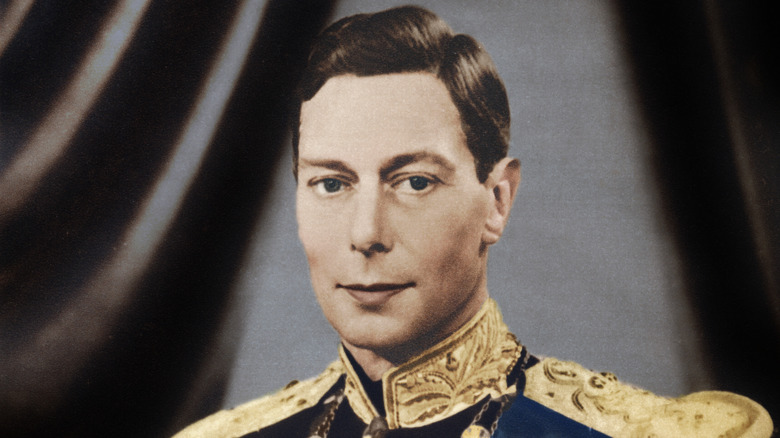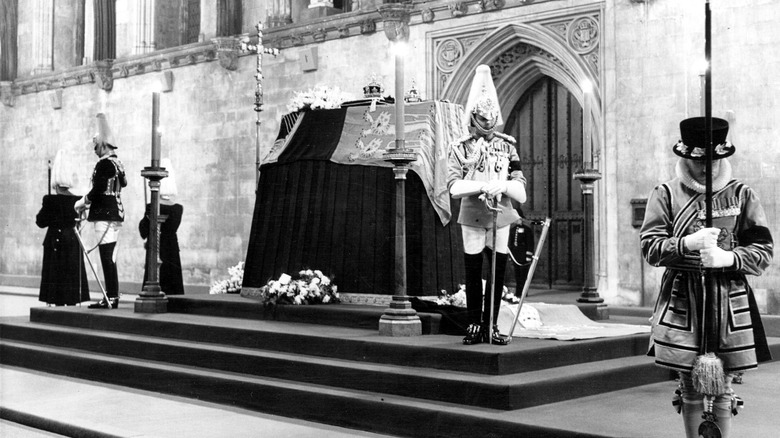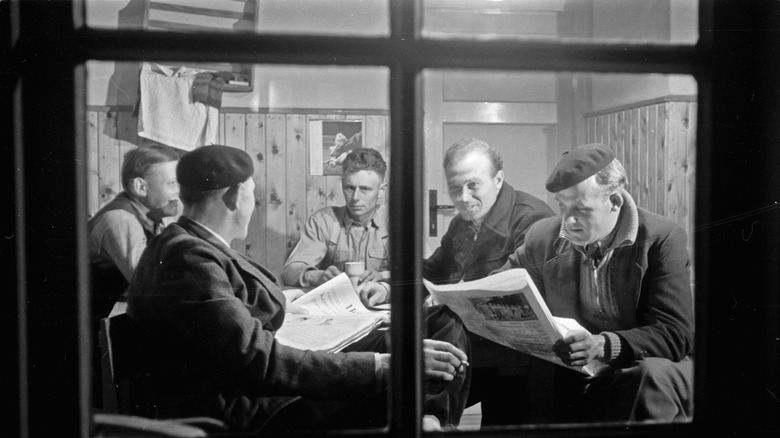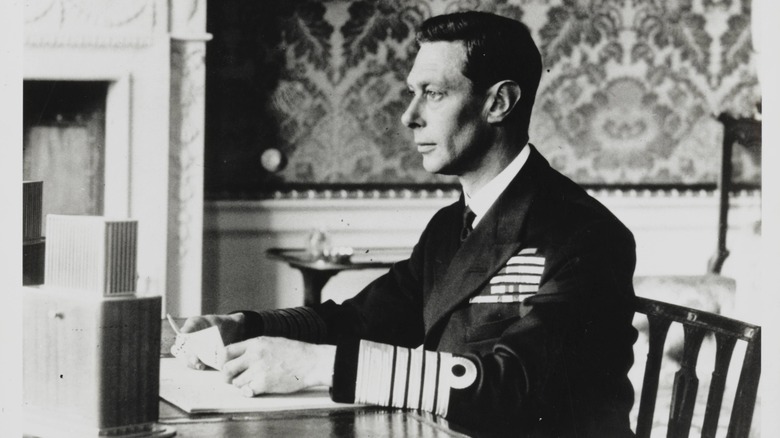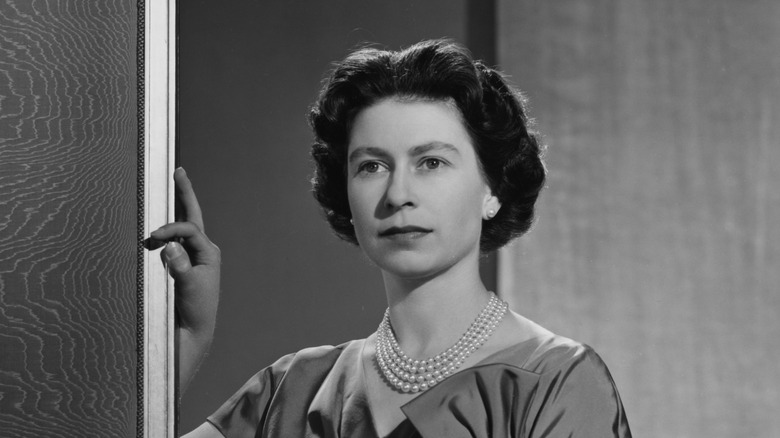How Did The World Find Out About King George VI's Death?
Communication technology is moving at unfathomable speeds. Albeit, this means news travels fast. Word on encroaching hurricanes and ravaging wars, the latest space travel tech, and deep-sea discoveries, and yes, celebrity deaths tend to reach us rather expeditiously. For example, when Queen Elizabeth II died "peacefully at Balmoral" in the afternoon per the Royal Family's announcement, on September 8, 2022, the world received word within about three hours of her passing (via NBC News). Oddly enough, even the three-hour lag between her actual physical death and the public announcement wound up being breaking news. Perhaps as a testament to the times, it seems people had anticipated receiving word immediately, not hours in the aftermath.
But such prompt communication was unavailable just one generation in the past. This much is evident in the way the queen's father, King George VI, died and the news was delivered. While there was no such thing as a Royal Family Twitter account back then, archived publications shed some light on the subject, from the events that transpired to the way the news was received (per The Telegraph).
King George VI died on February 6, 1952
According to History, King George VI, ruler of Great Britain and the Dominions of the British Commonwealth, died in the wee hours of the morning on February 6, 1952. While he was described as having died "peacefully in his sleep" evidence reported by the National Library of Medicine suggests he most likely died from metastatic lung cancer, a diagnosis that purportedly was kept a secret –- from the press, the public, the medical community at large, and even the king himself.
In 1951, King George VI underwent a total pneumonectomy from which he seemingly recovered. However, the word about his battle with a long-term illness took hold and was only further confirmed the morning he died, at the age of 56, leaving behind his wife and widower the Honorable Elizabeth Angela Marguerite Bowes-Lyon who was, incidentally, the first queen consort of the modern era (via the Royal Family). Their daughter, Elizabeth Alexandra Mary, who the world would come to know as Queen Elizabeth II, was just 25 years of age at the time of his death (via The Telegraph).
Much of the public didn't find out about his death until the following day
As you might imagine, just seven decades ago, there was a much larger lag in communication, especially with regard to international news. According to The Daily Telegraph, international newspapers (including theirs) did not break the news of the king's passing until the following day. Indeed, it was not until Thursday, February 7, 1952, that reports from around the world rolled in, describing his death as peaceful and informing the public of the fact that his last walk on palace grounds had taken place the previous evening.
It's notable to point out that world literacy rates in the 1950s were much lower than they are today. To shed some light on the subject, only about 56% of the global population could read in 1950 (via The Globalist) compared to 87% of the world's population today (per We Forum). What the world lacked in podcasts and video channels in the 1950s, it made up for though, with radio broadcasts delivered via the Prime Minister.
Headlines read 'The King is Dead'
The Telegraph reports that King George VI was discovered lying lifeless in his bed by a servant who was to greet him, as per usual, with his morning cup of tea. When several attempts to wake the king proved unsuccessful, the unnamed employee very discreetly alerted medical professionals. The atmosphere was funereal. Undrawn blinds and undrunk tea surrounded the bedroom where the village doctor, Dr. Ansell of Wolferton, declared that nothing medically could be done. Straightway, carpenters went to work constructing a coffin made from seasoned oak, right there on the palace grounds.
The Evening Standard, one of the first twelve newspapers to publish details on King George VI's death, reports that while the king was discovered dead at 7:30 a.m., even the local public received the news in a delayed fashion. The local public announcement came from Sandringham at 10.45 a.m., where it was said, 'The King, who retired to rest last night in his usual health, passed peacefully in his sleep early this morning.'"
The wording of this announcement is incredibly careful, given that the king's "usual health" was not good health at all. In their 1952 front-page headline, The Standard had a much more blatant announcement for its readers, titling their page simply "The King is Dead".
King George VI's death was received with shock by much of the public
According to archived reports from The Daily Telegraph, on the morning of the king's death, the gate surrounding the palace was bare, with no announcements emblazoned on the wrought iron perimeter. This means that even the local public went hours without receiving word of what had happened to their king. To quote these archives directly, "The first news that many had of his death was when they heard the sombre announcement on the wireless." "Wireless," in the 1950s, referred to radio lines, not Wi-Fi signals, per Merriam-Webster.
According to History Extra, when the public did find out that the middle-aged king was dead, they reacted with shock. Cinemas, sports arenas, and various venues were shuttered and this king, who had inherited the throne in a rather unexpected manner, continued to perplex the public even in death. The Telegraph goes on to report that confusion was stirred even within the medical community, as doctors presented multiple possibilities for the death of the king, ranging from blood clots to lumbar sympathectomy complications to circulatory issues. It has only recently been revealed that metastatic lung cancer was the most likely cause of all (via the National Library of Medicine).
Queen Elizabeth II received the news while in Kenya
According to The Telegraph, Princess Elizabeth was on a Commonwealth tour with her husband, Philip, when King George VI died. A coded message carried by cable was sent to Nairobi's Government House to inform Elizabeth of her father's death, but it was difficult to decipher because the message required a codebook and the keys to the safe that held the codebook were "unavailable." Finally, a BBC radio broadcast telling of King George's death was sent to Sagana Lodge — a farm belonging to Elizabeth that was near the Treetops Hotel where she was staying.
Elizabeth actually learned of her father's death from Philip, who was the Duke of Edinburg at that time (per Britannica). She reportedly received the news quite well, keeping a level head. She and Philip took an "emotional walk" on the grounds of Sagana Lodge, according to The Telegraph, and then she sat down and started dutifully writing telegrams to cancel the rest of her plans for the Commonwealth tour before starting the long journey home. Once there she immediately bore the crown, title, and responsibility of the queen.
